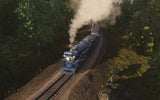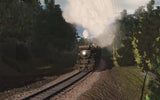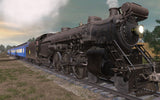In Game Downloadable Content (Requires Internet Connection)
Compatible with: Trainz Plus TRS22Jump aboard the famous Blue Comet passenger train, hauled by the CNJ's powerful G3s Pacific's in blue or black liveries, or the later weathered version as the P47 class.
The package includes the Baldwin G3s Pacific locomotive in early condition, in both blue and black liveries, and a custom cab interior. Also included is a representation of the class as it appeared in later life on duty after Blue Comet services had been discontinued.
The set of fully featured rolling stock includes baggage, combine, coach, diner and observation cars, and each comes with a detailed passenger view enabling you to immerse in the nostalgic atmosphere. Take a seat at a table in the dining car or sneak up for a peak at the galley. Ride in style in the lavishly appointed coaches, pull up a wicker chair in the observation car, stowaway in the baggage car or chew tobacco in the smoker.
The Blue Comet - the seashore's finest train
The Blue Comet was operated by the Central Railroad of New Jersey from February 21 1929 until September 27 1941. The train was something of an experiment conceived by Jersey Central president Roy Barton White. Frustrated with an unprofitable Pullman car lease, and eager to attract some of the larger Pennsylvania Railroad's patronage, White envisaged a new train that would satisfy the parlor car passenger and offer a competitive service between New York and Atlantic City.
The Pennsylvania Railroad had several advantages over the CNJ; it's terminal in central Manhattan was accessed via the Hudson River Tunnels and offered connections with services to Philadelphia from the same terminal. PRR offered several New York to Atlantic City Services, such as the famous Nellie Bly, the Sea Plane, and the Sea Gull; the latter carrying through Pullmans from various cities. An extra fare all parlor car service 'the Atlantic City Limited' left Pennsylvania Station, New York on Friday nights and returned to Manhattan leaving Atlantic City on Sundays as 'the New York City Limited'.
Making the CNJ's service attractive would mean packaging rail travel in a way never before seen, and planners devised a distinctive livery that would create a positive image and prominently display the Railroad's identity before shippers. The colors of Packard Blue, Royal Blue and Jersey Cream were selected to represent the sea and sky of the Jersey coast and arranged to give bystanders the impression of a comet streaking through the sky.
Two brand new Baldwin G3s Pacific's were initially assigned to haul the train, and subsequently another three locos entered Blue Comet service. Numbers 831-833 were painted in the Packard Blue color scheme. 834 was briefly painted olive green for service on 'the Bullet' between Jersey City and Wilkes-Barre and 835 was painted black.
A total of 16 cars were refurbished for the purpose at CNJ's Elizabeth Port workshops and each was named after a short-period comet, perhaps representing the relatively short length of the train's round trip.
For the price of regular coach travel, passengers enjoyed the extra-fare style extravagance of reserved seats in luxuriously appointed cars. Access to the smoking and observation cars came at no extra charge and an attractive dining car service was offered at modest prices.
Coach stock featured blue carpeted floors, triple cushioned seats covered in blue figured mohair with nickel plated coat hooks and umbrella holders. A men's lavatory and washroom was situated at one end of each coach, and at the other was an attractive women's lounge with connecting toilet.
The baggage/smoker combines contained a men's toilet and washroom, seats were covered in blue leather and each pair was furnished with a royal blue ashtray and nickel plated cuspidor.
Inside the observation car were 48 movable wicker armchairs and at the front end was a women's lavatory with separate washroom. The observation deck was furnished with 6 folding chairs and a large CNJ logo was centred on the floor. Attached to the rear was a drumhead carrying a Blue Comet logo.
The dining car 'Giacobini' was converted from 25 year old cafe car No.81. Steel plates were screwed on to the wooden body to give the impression of a modern steel car, though the wooden underframe remained. Truss rods and turnbuckles beneath the floor revealed the car's true vintage. The blue theme continued inside the car with blue carpet, napery and napkins. The Blue Plate special was 75 cents or for $1.25 passengers enjoyed a choice of fish, chicken or steak dinner. Baked apple pie with a slice of aged cheddar cheese was a popular dessert. After the meal, the full bellied passenger could select and purchase from a box of Anthony & Cleopatra cigars presented by the steward.
Passengers travelling from New York would begin their journey with a ferry trip over the Hudson, boarding the train at Jersey City Terminal. The Blue Comet rode over New York and Long Branch trackage to Red Bank, and then over the CNJ's own track to Winslow Junction, where it turned onto the Atlantic City Railroad's track to it's destination in Atlantic City.
The schedule initially consisted of two round trips daily, leaving New York at 11AM and 3PM and departing Atlantic City at 9:15AM and 4:35PM. The 136 mile (218.9km) journey took 3 hours and the average top speed was 75 miles an hour. The typical consist was made of baggage/combine/coaches/observation, with the dining car cut in ahead of the observation for the morning trip to Atlantic City and the evening return to Jersey City.
Despite the competition from the better connected Pennsy and the onset of the depression, the new train was initially a resounding success, carrying 62,105 passengers in it's first year and demonstrating that the traveling public appreciated the CNJ's model. As the depression deepened however passenger numbers fell steadily to half by 1932, and in 1933 the service was reduced to one round trip daily which further reduced annual ridership.
An expanding public highway system and the proliferation of the automobile contributed to the CNJ's falling fortunes and in 1939 the railroad reported a substantial operating loss. In 1940 the CNJ applied to the New Jersey Board of Public Utility Commissioners to discontinue Blue Comet services. The board was unsympathetic, implying that the Railroad had failed to adequately promote the service and that the departure times were inconvenient. Another request to abandon the service in 1941 was granted by the board, and the Blue Comet made it's farewell run.
Due to circumstances beyond the CNJ's control, the Blue Comet experiment had failed. The concept, however, was proven to have merit, ushering in an era of successful deluxe trains offering extra fare services at regular ticket prices.
| Platforms Supported: | PC & MAC |










































